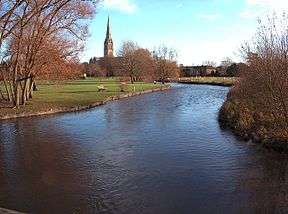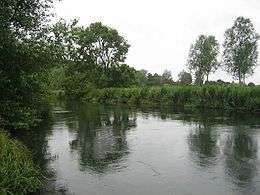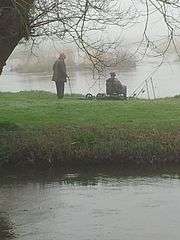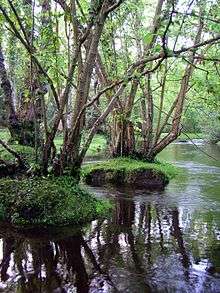River Avon, Hampshire
The River Avon (/ˈeɪvən/) is a river in the south of England. The river rises in the county of Wiltshire and flows through the city of Salisbury and the county of Hampshire before reaching the English Channel through Christchurch Harbour in the county of Dorset.
| River Avon | |
|---|---|
 The River Avon in Salisbury | |
| Location | |
| Country | United Kingdom |
| Country within the UK | England |
| Counties | Wiltshire, Hampshire, Dorset |
| Physical characteristics | |
| Source | |
| • location | Pewsey, Wiltshire |
| Mouth | English Channel |
• location | Mudeford, Dorset |
| Length | 96 km (60 mi) |
| Basin features | |
| Tributaries | |
| • left | Bourne |
| • right | Nadder, Ebble |
| Designation | |
| Official name | Avon Valley |
| Designated | 2 February 1998 |
| Reference no. | 926[1] |
It is sometimes known as the Salisbury Avon or the Hampshire Avon in order to distinguish it from the various other River Avons in England. It is one of the rivers in Britain in which the phenomenon of anchor ice has been observed.[2] The Avon is thought to contain more species of fish than any other river in Britain.[3]
Etymology
The river's name is a tautology: Avon is derived from the Proto-Brythonic word meaning "river", and therefore the river's name means River River.
Course
The Avon begins as two separate rivers. The western Avon rises to the east of Devizes, draining the Vale of Pewsey, and the eastern Avon rises just east of Pewsey adjacent to the Kennet and Avon Canal. These two merge at Upavon, flowing southwards across Salisbury Plain through Durrington, Amesbury and Salisbury. To the south of Salisbury it enters the Hampshire Basin, flowing along the western edge of the New Forest through Fordingbridge and Ringwood, meeting up with the River Stour at Christchurch, to flow into Christchurch Harbour and the English Channel at Mudeford.
All the significant direct and indirect tributaries of the Avon, including the Nadder, Wylye, Bourne and Ebble, converge within a short distance around Salisbury.
A short distance north from the river's western source is Morgan's Hill, which marks the hydrological triple divide of Great Britain, where rainfall drains into the English Channel (via this River Avon), the Atlantic Ocean (via the Bristol Avon and Severn Estuary) and the North Sea (via the Kennet and Thames).
About half of the length of the river is within Wiltshire, and only relatively short proportions are entirely within the current boundaries of Hampshire or Dorset. However, for part of its path the river forms the border between Dorset and Hampshire, and prior to the 1974 reorganization of local government the whole of the section now in or bordering Dorset was wholly within Hampshire. As there are two rivers with the name Avon in Wiltshire, this led to the river being popularly known as the Hampshire Avon or the Salisbury Avon (the other being referred to as the Bristol Avon).
The Avon Valley Path runs parallel with the river from Salisbury to Christchurch.


Rights of use
Court cases were brought in the 18th century concerning the loss of navigation of the river.[4] One was in 1737 and another was in 1772.[5]
Canoeists seeking legitimate access to the Avon have recently identified a long-forgotten Act in their favour. The "Act for making the River Avon navigable from Christchurch to the city of New Sarum" was enacted in 1664 under Charles II.[6] This act has not been repealed, hence remains in force and might provide a legal right of navigation.
However, the 1664 Act was subject to enabling works which were never completed, hence the suggestion of an implementable Act has fallen away. Whilst an Act was passed, the responsibility for delivery was given in 1685 to private undertakers in the names of Hodges, Bennett and Dennett, who were to fund the canalisation from Salisbury to Christchurch. They were allowed to charge their investment at 10% interest rate and could take full commercial advantage. Tripartite agreements from 1684 and 1685 evidence these agreements. The House of Commons journal of 31 January 1699 records that the freeholders, inhabitants and residents of Ibsley and Fordingbridge petitioned the House on the fact that they could not comply with the 1664 Act and were never likely to do so. These petitions were upheld by the House, thus the obligations and rights of the 1664 Act fall away as the works to canalise the Avon were never implemented.
Settlements
Wiltshire
Upper Avon Valley:
- Upavon
- East and West Chisenbury
- Enford
- Coombe
- Fittleton
- Haxton
- Netheravon
- Figheldean
- Milston
- Durrington
- Bulford
- Amesbury
Woodford Valley:
- West Amesbury
- Wilsford cum Lake
- Great Durnford
- The Woodfords
- Little Durnford
Salisbury:
Wiltshire watermeadows:
Hampshire:
Dorset:
Designations
In 1993 the Avon valley in Hampshire between Bickton (downstream of Fordingbridge) and Christchurch was designated as a Site of Special Scientific Interest (SSSI).[7]
In 1996 almost the entire river, from Patney (Wiltshire) to Christchurch, together with its tributaries the Wylye, Nadder, Bourne and Dockens Water, was designated as the River Avon System SSSI.[8]
Conservation initiative
A four-year project called STREAM began in September 2005. This £1 million project was designed to benefit the habitats of species such as water-crowfoot, Atlantic salmon, brook lamprey, sea lamprey, bullhead, Desmoulin's whorl snail, gadwall and Cygnus columbianus (Berwick's swan).[9] A sister project called Living River ran from 2006 to 2010, aiming to providing better access and recreation, as well as aid biodiversity.[10] Both these projects were shortlisted for the 2009 Thiess International Riverprize, competing against four other projects: the Yellow River in China, Lake Simcoe in Canada, the Polochic Basin in Guatemala and the Lower Owens River in the USA. The prize for 2009 was awarded to Lake Simcoe.[11]
See also
- Other Rivers Avon
- Rivers of the United Kingdom
References
- "Avon Valley". Ramsar Sites Information Service. Retrieved 25 April 2018.
- Hoodless, W.A. (2010). Christchurch Curiosities. The History Press Ltd. p. 29. ISBN 978-0-7524-5670-6.
- Wright, John (2003). Discover Dorset, Rivers and Streams. Wimborne, Dorset.: Dovecote Press. p. 41. ISBN 1-904349-10-2.
- Cross, Donald Alfred Edgar (1970). "The Salisbury Avon Navigation". Industrial Archaeology. David & Charles. VII (2): 121–135.
- The National Archives. "Material for the History of Wiltshire Canals: Salisbury Avon Navigation". Your Archives. The National Archives. Retrieved 17 June 2010.
- "1664 Law Could Prove Right To Row". BBC News. 23 February 2007.
- "Designated SSSI Avon Valley Bickton to Christchurch". Natural England. 2017.
- "SSSI detail: River Avon System". Natural England. Retrieved 21 April 2020.
- Stream project website
- Living River Project Website
- 2009 International Theiss Riverprize
External links
![]()
